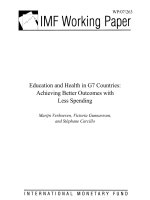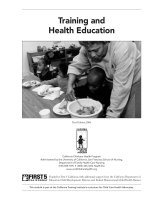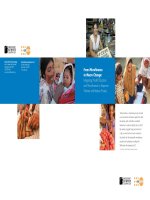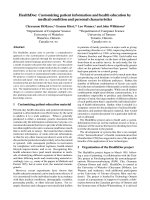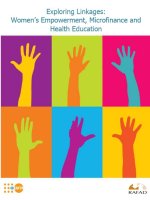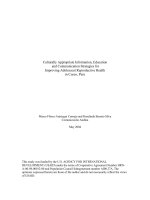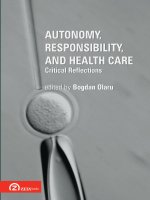EDUCATION AND HEALTH - POLICY DISCUSSION DOCUMENT potx
Bạn đang xem bản rút gọn của tài liệu. Xem và tải ngay bản đầy đủ của tài liệu tại đây (469.44 KB, 42 trang )
EDUCATION AND HEALTH
POLICY DISCUSSION DOCUMENT
March 2012
TOWARDSTHE2012ANCNATIONAL POLICYCONFERENCE
Glossary
ABET –AdultBasicEducationandTraining
ANA–Annual National Assessments
CAPS – Curriculum andAssessmentPolicy Statements
CEM –CouncilofEducation Ministers
DBE –DepartmentofBasicEducation
DHET – DepartmentofHigher Education and Tra in ing
DoH–Department of Health
DST–Department of Science and Tec hno log y
DTI–Department of Trade andIndustry
ECD –Early Childhood Development
EPWP–ExpandedPublicWor ks Program
FET–Further Education andTraining
HEI–HigherEducationInstitution
NEEDU–National EducationEval uation and Development Unit
NHI–National Health Insurance
NHIF–National Health InsuranceFund(NHIF)
PSETA –PublicSectorEducationandTra ini ngAuthority
SETA – SectorEducation and TrainingAuthority
2
TOWARDSTHE2012ANCNATIONAL POLICYCONFERENCE
Structure of the Paper:
1. Introduction and background.
2. Scopeofthe discussionpaper.
3. Cross‐cuttingissuesfor all sectors.
4. Sectoraldiscussion.
5. Draft resolutions.
6. Annexure.
7. References.
Introduction andbackground
This submission by the ANC NEC Subcommittee on Education and Health is
designedto stimulate debates intheorganisationonachievementsmadeand
challenges experienced by the ANC in implementing policies and programs in
Basic Education, Higher Education & Training, Health and Science &
Technology. It seeks to assist the
membership of the ANC to assess the
impact of our work since 1994, which involved designing ANC policies and
programs to transform South Africa from apartheid to democracy, translating
those into government policies and programs, and ensuring their successful
implementation intheANCandgovernment for abetter lifefor all.
Discussions guided by this paper must be used to rekindle discourse in all
sectors of our society and our movement on the ANC policy process. The
resolution of the 50
th
National Conference noted that since 1994 the point of
gravity as regards to policy development appears to have shifted to
government and away from ANC constitutional structures. It resolved to
enhance the depth and extent of ANC capacity to sustain an on‐ going cycle
of policy development, implementation and monitoring; and also
adopted a
diagrammatic aid to a better understanding of the ANC policy process.
Discussions of reports and proposals contained herein should assist the ANC
to evaluate current policies thereby identifying policy gaps and designing
policy proposals; assist the ANC to plan for the next five years of
governance; help the movement to review existing documents on our vision
of the ANC and South Africa in the next twenty years up to 2030; and get
branches of the ANC to agree on our vision of the ANC and South Africa a
hundredyears fromnow, viz.theANCandSouthAfricaof2112.
The ANC played a
leading role in the liberation of South Africa. It was
throughout its existence and remains even today a leader of our people in
thestruggle againstoppression and inequities.
3
TOWARDSTHE2012ANCNATIONAL POLICYCONFERENCE
As the oldest party of revolution in Africa, the ANC was a beacon for many
liberation movements and remains a leader, a shining example and the only
hope for manyat home,inSouthernAfrica,therest of Africaandbeyond.
Most policies of the ANC evolved over the years. ANC policies and programs
are a product of work of the leadership and membership of the ANC, ANC
interaction with fraternal organisations at home and abroad, especially
membersof the Tripart it e Alliance, and constant interactionand engagement
with various formations such as traditional, religious, business and labour
organisationsinSouth Africa andinothercountries.
The correctness of ANC policies is one of its strengths that results from the
fact that, as the oldest liberation movement in Africa, its policies are a
reflection of its growth and maturation as a movement of the people of
South Africa. This is, amongst others, what qualifies the ANC to be and
remain the organisational leader of change in SouthAfrica.
At the dawn of democracy in 1994, the ANC implemented the Reconstruction
and Development Program (RDP), a program designed to mobilise all out
people and resources to bury apartheid and build a democratic state in its
place. The RDP was a plan that
was designed to address socioeconomic
problems that were facing our country such as inadequate education and
health care, violence and a fai ling economy. Most goals of its
implementation were met, but much morestill needs to be done.
The 2007 Strategy and Tactics of the African National Congress states that
“d u r i n g the First Decade of Freedom, we were able to consolidate and
deepen our democratic programs for social transformation. The progress we
have made is commendable; and the decisive actions in the early years of
the Second Decade of Freedom hold out the promise of faster progress
towards our ideals”. It further states that the ANC celebrates the end of its
first century of its existence wielding political power, a critical platform to
improve the quality of life of South Africans and contribute to building a
better world. It confirms that the strategic task remains the same, but that
the environment in which it has to be pursued has changed significantly for
thebetter.
In his closing address at the conclusion of the 52
nd
National Conference held
in Pol okwane in 2007, the President of the ANC, Cde Jacob Zuma, reminded
us that
“ …as a collective and through our structures, we need to create
a united ANC that recognizes the legacy left by comrades OR
Tambo,AlbertLuthuli andNelson Mandela”.
He had earlier said that
we are also going to sharpen our policy instruments
with a view to having a direct impact in our fight against poverty,
unemployment and underdevelopment. This remains true and valid in our
pursuit to building aneffective ANC at all levels of society.
The NEC subcommittee on Education and Health processed and
translated
relevant resolutions of the 52
nd
ANC National Conference into ANC and
4
TOWARDSTHE2012ANCNATIONAL POLICYCONFERENCE
government policy and programs. These resolutions are integral to elections
manifestos of 2009 and 2010, and therefore are the basis of the ANC
ProgramofActionandgovernmentmandate.
This discussion document contains progress reports on the implementation
of resolutions of the National Conference and subsequent NEC meetings by
all sectors in the Subcommittee. Annexure 1 is a detailed progress report in
tabular form.
This policy document must therefore be one of our rallying points as we
celebrate the centenary of the ANC. Contributions to debates rai sed in this
paper mustensurethatthe ANC remains the leader of our revolution and the
guarantorofdemocracyfor all freedom‐ lovingpeopleof South Africa.
Scope of the discussion paper
This policy paper covers the followingsectors:
• Basic Education.
• HigherEducation and Trai ning.
• Health.
• Science andTechnology.
This paper responds to the directive of the National Executive Committee
(NEC) that policy papers must be guided by and focus mainly on the
following questions:
1. Whatare current ANCpolicies?
2. Whatdecisions havebeen taken?
3. Arethepoliciesbeingimplemented?
4. If not, what are the challenges? Are these intrinsic to policy or are
theserelated to implementation?
5. How are the new proposals relate d to the National Development Plan
and theNew Growth Path?
6. HowdoestheANC respond to this situation?
7. Doesconference need to adoptnewpolicyand,ifso,inwhicharea(s)?
It therefore provides, for each of the sectors, the ANC and government policy
context and re ports on specific projects and programs. It also identifies
policy gaps and proposesresolutions forthePolicy Conference.
Cross‐ cuttingissues forall sectors
1. Implementationofconference resolutions, monitoringandevaluation
5
TOWARDSTHE2012ANCNATIONAL POLICYCONFERENCE
Over and above contributing to the strengthening of coherence,
cohesion and coordination in the movement, sectors in the
Subcommittee on Education and Health prioritised the implementation
of conference resolutions plus monitoring and evaluation. This is
critical for effectivedelivery.
2. Job creation, employment, economic development and sustainable
growth
Job creation remains the topmost priority for our country in our fight
against poverty, unemployment and inequality. Education and health
are most critical sectors in ensuring a vibrant economy. They also ra nk
amongst sectors thatare highly labour‐intensive.
In the past four decades, several countries have shown that economic
development, sustainable growth and employment can be achieved
through investment in science, technology and innovation. Countries
such as Singapore, South Korea, Japan, Germany and the United States
of America have devoted policy and resources to developing a
knowledgeeconomy asafoundation for prosperityand progress.
More recently Brazil, Russia, India and China known as the BRIC
countries followed these examples and derived much benefit from
their knowledgeeconomies.SouthAfrica must do the same.
3. Theestablishment of a state‐ owned publishing enterprise
The country experiences challenges in the production, distribution and
availability of textbooks and other instruments or vehicles of
knowledge production. Our methods and practice of acquisition from
the private sector plus distribution in government are, in some cases,
neithercost‐ effectivenorefficient.
4. Protectionandactive promotion of indigenous Africanlanguages
Our indigenous languages and our use of mother‐ tongue are a source
of pride and identity. Language plays a central role in the preservation
and propagation of a people’s cultures. It is alarming that
some of our
schools have discontinued teaching African languages. Some of our
6
TOWARDSTHE2012ANCNATIONAL POLICYCONFERENCE
universities have down‐graded or closed down departments of African
languages.
The ANC has a duty to protect and promote indigenous languages of
South Africa. The movement has a responsibility of providing
leadership to our people to realise that indigenous African languages
are not inferior, and that they should be promoted and be developed
for educational achievements. For this task to succeed, we need the
involvement of communities and the collaboration of the education
sector with other sectors such as science and technology, arts and
culture; and legislature and governance. Families and traditional
leadersalso needtoplayanimportantrole in this project.
5. Correctingskills shortagescreated by some professional associations
The conduct and practice of some professionalassociations such as the
actuarial and legal fraternities result in newly graduated professionals,
Blacks in general and Africans in particular, being blocked from entry
into many professions. This creates artificial scarcity of skills and
result in an increase in qualified but unemployed professionals. The
ANC must find effective ways of ensuring that these blockages are
removed wherever and whenevertheyoccur
6. InformationandCommunication Technology
The ANC advocates the rational use of ICT in our schools, FET colleges,
universities, clinics, hospitals and other faci lities as this is demanded
of usduringthis computer
ordigitalage.
7
TOWARDSTHE2012ANCNATIONAL POLICYCONFERENCE
Discussionsfocusing onsectorsmakingupthesubcommittee:
Basic Education
ANCPolicy context
The ANCPolicy context isframed by the Polokwane resolutions. These are:
1. TheoverarchingvisionthatinformsANCeducationpolicyisPeople'sEducationfor
People'sPower.
2. Vulnerablechildrenofveteransmustbe takencareofbythestate.
8
Questions:
Howdomembersofourbranchparticipateinpolicy‐makingintheANC,
especiallyoneducation,health,science,technologyandinnovation
issues?
HowdoANCstructuresensureimplementationofANCandgovernment
policiesandprogramsplusmonitorandevaluateimplementation?
Howdomembersofourbranchcontributetopolicymakingand
implementationofprogramsinourlocalmunicipality?
Whatstructuresarenecessaryorexistinourlocalbranch,district,and
ProvincialExecutiveCommittee(PEC)toimplementconference
resolutionsoneducation,health,science,technologyandinnovation?
Howdodeployedcomradesaccounttothebranchandourcommunityfor
theirimplementationofpolicyand
programs?
TOWARDSTHE2012ANCNATIONAL POLICYCONFERENCE
3. Careerguidancebeacompulsorysubjectfromgrade8upwards.
4. Wemustprogressivelyexpandtheschoolnutritionprogrammetoincludehigh
schoollearnersinpoorercommunities.
5. Nationalnormsandstandardstobedevelopedtodeterminetheroles,functionsand
responsibilitiesofdistrictoffices.
6. Normsandstandardsshouldbedevelopedtoclassifyschools,giventhevariationof
schooltypesinprovinces.
7. ApolicyonaffirmativemeasuresforHDIswithspecificemphasisoninfrastructure,
accessandstaffprovisioning
8. Thedualityofpublic servantselectedascouncillorsunderminesbothoreitherofthe
twowithregardstoefficiencyandthismustbereviewed.
9. Toaffirmthatallprincipalsshouldundertakealeadership,managementand
governancecourse
10. ToreviewAdultBasicEducationandTraining(ABET)soastoensurethatitbetter
respondstotheskillsdemand.
11. Theestablishmentofanationaleducationevaluationanddevelopmentunitfor
purposesofmonitoring,evaluationandsupport.
12. Thenofeeschoolsbeexpandedto60%by2009.
13. Progressivelyintroducefreeeducationforthepooruntilundergraduatelevel.
14. TheANCtofocusrigorouslyonthequalityofeducation.
15. Educationmustbeprioritisedasoneofthemostimportantprogrammesforthenext
fiveyears.
16. Maths,scienceandITmustbepromotedandsupported,includingthroughSaturday
tutorialprogrammesandbursariesbeofferedtoteachersinthisareas.
17. Newcurriculummustbeaccompaniedwithskillsdevelopmentofteachers.
18. BuildingofschoolstoreplacemudschoolsmustbeincludedintheExpandedPublic
Works(EPW)programme.
19. Weshouldrecruitfromforeigncountriesonscareskillssuchasmathsandscience.
20. TheNECshouldcriticallyconsidertheoutcomesoftherecentlyheldeducation
summitwithaviewtoimplementingtheproposalsthatemerged.
Governmentpolicycontext
TheDepartment’s ActionPlanto2014 andDeliveryAgreement framegovernmentpolicy.
These in turn are informed by the Polokwane resolutions. In order to support the
achievementofthegoalssetbyPolokwane,BasicEducationsetoutthefollowingpriorities:
• By2014,allchildrenwillparticipateinGradeR;
• Alllearnersandteacherswillbeengagedinlearningandteachingfortherequisite
numberofhoursperday;
9
TOWARDSTHE2012ANCNATIONAL POLICYCONFERENCE
• BasicEducationwilldistributeappropriatelearningandteaching materials toall
schoolstoensurethatallteachersandlearnershaveaccesstobasicteaching and
learningsupportstoenablethemtocoverthecurriculum;and
• Standardised nationalassessmentsofthequalityoflearningwill takeplaceinall
publicschools.
Targetswereestablishedforgrades3,6,9and12.TheDepartmentofBasicEducation(DBE)
undertookidentifiedAnnualNationalAssessments(ANA)asastrategictoolformonitoring
and improving the level and quality of basic education, with a special focus on the
foundational skills of literacy and numeracy. DBE conducted the first countrywide ANA
whichinvolvedapproximately6millionlearnersingrades1‐6inFebruary 2011.Theresults
werereleasedon28June2011.
ThepurposeofANA, asimplementedin2011,was to obtainacredible status reportof
learnerperformanceinLiteracyandNumeracyas DBEworkstowardsthegoalofimproving
learnerperformancein linewith commitmentsmadeby government.ANA hastherefore
providedthe Departmentwithinformationthat assistsinidentifying areaswhere urgent
attentionisrequiredinordertohelpimprovesuccesslevelsoflearners.ANAisalsomeant
toprovideteacherswithexamplesofcredibletestingpractices.
TheresultswerewidelyreportedinJune2011.Mostworryingwasthedeclininglevelsof
performanceoflearnersfromgrades 1to6. Thenotablyhigher performanceinGrades1
and2,inbothLiteracyandNumeracy,canbeattributedtotheinterventionsofGovernment
withregard to Early Childhood Development. But overall, the results leave no room for
complacency.
Government set itself a target of ensuring that 60% of grade 3, 6 and 9 learners must
functionat“acceptablelevels”inLiteracyandNumeracyby2014.
The ANA results have provided valuable information for the system to benchmark
performance in both Literacy and Numeracy so as to track progress towards the
achievementofsettargetsas wellasmonitoringgaps.Theresultsalsoenableanalysisto
identifyandremedyareasofweakness.
Plannedinterventionsin2011includedthefollowing:
1. DBEundertookworkingsessions withrelevantroleplayersineachoftheprovinces
to discuss the ANA findings, explore further possible analysis to extract detailed
informationfromthedataanddiscussionofguidelinesonhowtoutilisethedatafor
interventionsandtargetsetting.DBEdevelopedtheguidelinesanddistributingthese
toschools.
2. Governmentalsoprintedworkbooks for6millionlearners.In2012,workbooksare
beingdistributedtolearnersinGrades7‐9.Thisisamassiveinterventionandreports
fromteacherstellusthattheworkbooksarebothvisuallystimulatingandexciting
andaredefinitelyservingthepurposeforwhichtheywereintended.Eachworkbook
10
TOWARDSTHE2012ANCNATIONAL POLICYCONFERENCE
ismadeupof128easy‐to‐followworksheetstoimprovelistening,reading,writing
andnumeracyskills.
3. DBEcompletedtheCurriculumandAssessmentPolicyStatements(CAPS)whichare
beingphaseintotheFoundationPhasein2012.TheCAPSbuildontheFoundations
forLearningandprovidemoretimeforlanguagesandmathematics(orliteracyand
numeracy). Itisexpected,therefore,thattherewillbemuchmorefocusedteaching
andassessment.Butthiswillbesupportedwithguidedteacherdevelopmentand
appropriate readers and workbooks. Theworkbooks thatwere distributed earlier
this year, were developed in synchronisation wi th the CAPS. They should assist
teachers in pacing and sequencingtheir workbetterasthey consist of attractive
worksheetstobeworkedondailyandonaterm‐by‐termbasis.
4. DBEhastrainedsubjectadvisorsandprovincesarecontinuingwiththetrainingof
teachers. Basedon whatANAresults show,thereisamorescripted approachto
teacherdevelopment.Thisincludestrainingandsupporttoteacherstohelpthem
manage and use efficient methods to teach specific content areas that the
assessmenthasshowntobeparticularlychallengingtolearners.
5. DBE is developing “banks” of good quality exemplars of assessment in each of
literacyandnumeracyanddisseminatetheseforteacherstouseintheirclasseswith
necessary support from the districts. The exemplar assessments will help align
school‐basedassessmentwithANA andthusestablishanintegrated and seamless
assessmentsystem.
6. The curriculum review process in 2009 showed that there is far too big a leap
betweentheFoundationPhase(Grades1‐3)andtheIntermediatePhase(Grades4‐
6).Learnersjumpfromthreesubjectsto eight.Thismayaccount for the dropin
resultsthatANAshowshappensaschildrenmoveupthegrades.The Department
has reduced the number of subjects in the Intermediate Phase, and will begin
implementationoffewersubjectsinGrades4‐6in2013.Theplanistoensurethat
theemphasisonthefoundationalskillswillcontinuetobestrengthened.
7. ThejumpfromGrade3 to 4is mademoredifficultwiththeswitch toEnglishin
Grade4.ManyschoolsswitchfromtheirhomelanguagetoEnglishfrom Grade4.
TheaffectedlearnersoftenlackbasicskillsinEnglishandstruggletocopewiththe
demandsoftheGrade4curriculum.Researchhasshownthatlatertransitionfrom
homelanguagetoLanguageofLearningandTeaching,wheretheydiffer,negatively
affectslearningoutcomes.In2010,theCouncilofEducationMinistersapprovedthe
recommendationthatfrom2012,thelanguagechosenbythelearnerasaLanguage
ofLearningandTeachingfromGrade4shallbe
taughtasasubject,fromGrade1,
andnotfromGrade3asiscurrentlythecase.
8. From2012,alllearnersinGrades1‐3arerequiredtotake4subjects,thatis,Home
Language, First Additional Language, Numeracy and Life Skills. All learners whose
Language of Learning and Teaching will be English from Grade 4 onwards are
requiredtotakeEnglishasasubjectfromGrade 1. What this means is that the
11
TOWARDSTHE2012ANCNATIONAL POLICYCONFERENCE
teachingofEnglishwilloccuralongsidehomelanguageinstructionforthoselearners
whochooseEnglishasaLanguageofLearningandTeachinginlatergrades.
9. Englishwillnotreplacethehomelanguageintheearlygrades.Eachlearnerwillbe
taughtinhisorherhomelanguageintheearlygradeswhereitispracticallypossible.
ThemovetoEnglishinGrade1isintendedforthoseschoolswhosehomelanguage
isnotEnglish.ThechallengewillbeimprovingtheEnglishlanguageskillsofteachers
whosemothertongueisnotEnglish,buttheDBEiscommittedtodoingthisthrough
arangeofprogrammes.
10. Everygrade up requires support further down. DBE has, accordingly, also placed
increasingemphasisontheimportanceofEarlyChildhoodDevelopmentandGradeR
forlearners.Tosupporttheobjectiveoflayingsolidfoundationsforlearningfroman
earlyage,DBEisworkingtowardsuniversalaccesstoGradeR,by2014.Thisindeed
has been one of our great successes, with access expanding dramatically in the
recentpast.
11. Theevidenceisuncontested thatchildrenwhohaveattendeda centreorschool‐
based pre‐school programme in the year before school entry perform better on
assessmentsofreadingandmathskills.DBE’staskremainstoimprovequalitatively
thelevelofqualificationsofGradeRteachers toensurethatwereachourgoalof
quality learning and teaching at this level as well. These early interventions are
bearingfruitwith thefairlygoodperformanceoflearnersintheANAinGrades1and
2. The DBE will continue to strengthen the interventions in Early Childhood
DevelopmentandGradeR.
12. TeachersarecentraltothesuccessofthenewapproachthatDBEisadopting.DBEis
strengtheningteacherdevelopmentprogrammesguidedbytheIntegratedStrategic
Planning Framework for Teacher Education and Development that was launched
earlier this year in conjunction with the Department of Higher Education and
Training. Here the focus is firmly on more targeted, subject‐specific teacher
educationanddevelopmentthatwillimproveteachercontentknowledge.
13. DBE is also strengthening the campaign to attract young people to the teaching
professionthroughour FunzaLushakaBursaryprogramme.Thereisastrongfocus
onrecruitingthebestofyoungpeopletotheteachingprofessionandthatteaching
shouldbeseenasaprofessionoffirstratherthanlastresortforourtalentedyouth.
14. The ANA results have clearly demonstrated that there is need for an effective
monitoringandevaluationsystem throughwhichthe qualityofeducationcan be
continuously enhanced. The Action Plan to 2014: Towards the Realisation of
Schooling 2025 and the Delivery Agreement for Basic Education provide specific
goalsagainstwhichtheperformanceofthesectorwillbemeasuredandevaluated.
Thiswillbedonebyholdingalllevelsofthesystemaccountableforwhattheyare
requiredtodeliver.
12
TOWARDSTHE2012ANCNATIONAL POLICYCONFERENCE
15. The DBE broad strategy for improving accountability is anchored around the
followingfourpillars:‐
• Strengthening the culture of performance management within the education
system;
• Simplifyingandaligningtheevaluation instrumentsthatmeasureperformance
standardsforeducators;
• Strengtheningmonitoringandsupportforeducators;and
• Strengtheningreportingatalllevels.
16. DBEhasestablishedtheNationalEducationEvaluationandDevelopmentUnit
(NEEDU)thatwillalsohelpinevaluatingtheeducationsystem.NEEDUwillidentify
criticalfactorsthatinhibit oradvanceschoolimprovementandmakefocused
recommendationsforredressingtheproblemareasthatundermineschool
improvement.
Some of the ke y decisions made between conferences
• BasicEducationSectorDeliveryAgreementsigned in 2010.
• NEDLAC Accord on Basic Education signed to give effect to president’s
call for education to be a societal issue.
• Establishment of a Planning and Delivery Oversight Unit in the DBE in
2011.
• IntegratedNational Literacy and NumeracyStrategyadoptedby CEM.
• Guidelines Relating to Planning for Public School Infrastructure as well
asGuidelines for BoardingFac ilit ie s was approvedbyCEM.
• Release of NEEDUBillfor public comment.
• Performance Agreement of Principals and Deputy Principals.
• Career guidance is a compulsory subject, as part of Life Orientation,
fromGrade4.
Reports on theimplementationofpolicyandspecific
projects of programs
• The following is a summary of Action Planto 2014:
¾ The plan is a strategy of the Department of Basic Education to
strengthen weak areas in the education system that have been
identified as needing support. It has been developed in line with
the Presidency’s 2009 National Strategic Planning and draws
direction from the guiding document Improving Government
Performance:Our approach.
¾ Byimproving performance in these identifiedareas, learners will
benefit from a higher quality education. The nation as a whole
will also benefit as school graduates with better skills and
knowledge levels enter further and higher education and the
workplace.
13
TOWARDSTHE2012ANCNATIONAL POLICYCONFERENCE
¾
Short‐ term goals and long term vision: The Action Plan sets out
goals that the national educationsystem willbeworking towards
and the actions to achieve these goals by 2014. These are the
first steps towards realising the bigger, more long‐ term vision of
quality educationin schools by 2025 called Schooling 2025.
¾ Everyone has a part to play: The Action Plan indicates, as far as
possible, activities that each stakeholder should engage in to
realise each goal in the plan. It also suggests ways that those
outside the education syste m could provide resource resources
and/orexpertise to support theplan.
¾ Clear goals and flexible strategies: The Action Plan sets 13 goals
of which deal with outputs to be achieved in relation to learning
and enrolments. It also sets out 14 areas which need to be
improved to achieve these goals and outputs. The approach
allows a degree of flexibility for schools and communities to
devise their won strategies to suit their specific circumstances.
¾ Measuring progress through Annual National Assessments
(ANA): Each year all learners in Grades 1 to 6 will write national
tests in languages, that is home language and first additional
language, and mathematics at the end of the year. The purpose
is to establish an objective national benchmark by which to
measure literacy and numeracy achievement levels in primary
schools, so that improvements can be accurately assessed and
appropriate interventions designed where additional support is
needed. ANA tests have also been introduced for Grade 9
learners. Parents and School Governing Bodies (SGBs) will
receive relevant ANA results to allow themto comparetheirown
results with those
of other learners and schools.
• The following is a summary of Schooling 2025:
¾ Schooling2025 is a long‐ term plan for the basic education sector
which will allow for the monitoring of progress against a set of
measurable indicators covering all aspects of basic education
including amongst others enrolments and rete ntion of learners,
teachers, infrastructure, school funding, learner well‐ being and
school safety,massliteracyand
educational quality.
¾ By 2025 we mustseethefollowing:
Learners who attend school every day and are on time because
they want to come to school, the school is accessible, and
learners know that if they miss school when they should not,
some action will be taken. These learners understand the
importance of doing their schoolwork at school and at home.
They know that their school will do everything possible to get
them to learn what they should. Much learning happens through
the use of computers and from Grade 3 onwards all learners are
14
TOWARDSTHE2012ANCNATIONAL POLICYCONFERENCE
computer literate. Part of the reason why learners want to come
to school is that they get to meet friends in an environment
where everyone is respected, have a good meal, and know that
they can depend on their teachers for advice and guidance. They
also know that they are able to participate in sporting and
culturalactivitiesorganisedatschool after school hours.
Teachers who have received the training they require are
continuously improving their capabilities and are confident in
their profession. These teachers understand the importance of
their profession for the development of the nation and do their
utmost to give learners a good educational start in life. They are
on the whole satisfied with their jobs because their pay and
conditions of service in general are decent and comparable to
that of other professions.
A school principal who ensures that teaching in the school takes
place as it should according to the national curriculum, but who
also understands his or her role as a leader whose responsibility
is to promote harmony, creativity and a sound work ethic within
the schoolcommunityandbeyond.
Pare nts who are well informed about what happens at school
and receive regular reports about how well their children
perform against clear standards that are shared by all schools.
These parents know that they are listened to, and that any
concerns will be dealt with by authorities at all levels of the
education system.
Learning and teaching material in abundance and of a high
quality. The national Minimum Schoolbag policy which is widely
understood describes the minimum quantity and quality of
materials that every learner must have access to. Computers in
the school are an important medium which learners and teachers
accessinformation.
Schoolbuildingsand facilities that arespacious, functional, safe
and well‐ maintained. Learners, teachers and parents look after
their buildings and facilities because they take pride in their
school.
• There is a need for the ANC to discuss once more the relevance of
vocational training at schoollevel,ifany.
Proposals and comments on the National Development Plan and the New
GrowthPath
The National Development Plan made a number of recommendations. Some
of these are already being implemented. These include giving more support
to poorly functioning and performing schools, clarifying the role of districts,
expanding Funza Lushaka teacher bursaries, changing the process of
15
TOWARDSTHE2012ANCNATIONAL POLICYCONFERENCE
appointing new principals, building a political consensus around a social pact
and providing moresupport to professional andschoolgoverning bodies.
The Department has already started to work on realising other proposals.
These include working towards the targets identified for 2050, with which
the Department is in agreement, and mobilising technical professional
capacity to assist inschoolimprovement.
In line with the Integrated National Teacher Development Framework agreed
on in 2009, The Department is in fav ou r of teacher self‐ diagnostic rather
than externally‐ managed competency tests. The Department is also sceptical
aboutthe feasibility of linking teacher pay to learner scores.
The New Growth Path sets out ke y economic drivers with which the
Department is in broad agreement. Jobs and sound education and skills
development are the foundation stones of a thriving economy and
prosperoussociety.
ANCpolicygaps and proposalsofANC response
• National policy for rural multi‐ grade teaching, as per resol ution of the
2011 ANC Lekgotla.
• Language policy and attendant teacher development (introduction of
English to Grades 1and2).
• Class size; over 8 000 ordinary public schools have average class sizes
above the normof40.
• The drop‐ out rate ingrades9‐11.
• Declining number of mathematics candidates, decreased numbers of
physical sciencepassesandquality of passes in senior certificate.
• Teacher attendance and completing annual programmes.
• Wo r kb o o k use.
HigherEducation andTraining
ANCPolicy Context
South Africa is face d with the challenge of transforming its economy and
growing it rapidly to deal with unemployment. The economic growth rate has
been limited by low level skills which affects the state’s ability to reduce
high levels of unemployment in the country. These high levels of
unemployment exist alongside high levels of skills shortage. For example
there are around 2.8 million unemployed youth, who are not in any training
institution and are not disabled. They are unable to take advantage of
opportunities that exist partly limited by their skill levels.The limited skills
affect the economic growth path which this government wishes to embark
on.
16
TOWARDSTHE2012ANCNATIONAL POLICYCONFERENCE
In 1994 the African National Congress published its Policy Framework on
Education and Training in a document which became known as the Yellow
Book. This was the culmination of a long process of policy development in
which the ANC and its allies had engaged over a period of time. One of the
most important policy positions of the Yellow Book is that education and
trainingispartofanintegralwhole.
Provision of post‐school education, through higher education institutions,
Further Education and Training and other vocational colleges, adult learning
centres, organisations which provide professional development, and
organizations which focus on youth development, has been fragmented.
There is as yet little integration across different types and sites of provision.
It is still difficult for students to move between colleges and universities,
between different universities, between schools and post‐ school institutions,
and between educational provision and the world of work.
The ke y focus is to build and sustain a single coherent post‐ school education
and training system. The central problem that seeks to be addressed is
balancing on the onehand,the expansion of access to education and training
opportunities, to enable the development of human potential, so that every
person is able to contribute freely to society, advance common values, and
increase socially useful wealth, and, on the other hand, achieving high‐ level
of excellence, research, and innovation. The post‐school education and
training system has to be structured both to meet the aspirations of youth
and adults and to ensure that education, training and skills development
initiatives respond to the requirements of the economy, our rural
development challenges, and the need to develop an informed and critical
citizenry.
GovernmentPoli cy Context
The mandateof the Department of Higher Educationand Training is to create
a single, coherent, differentiated and highly articulated post‐ school
education and training system in line with outcome 5 of the 12 government
outcomes,which is the production of “a skilled and capable workforce for an
inclusive growthpath”.
Some of ke y decisions made between conferences:
1. Develop a comprehensive policy proposal on the provision of free
education.
2. Financial supportfor post‐ graduatestudents.
3. Accommodationfor students inthepost‐school system.
4. Linking infrastructure programs to skills training and workplace
experiential learning.
5. Strengthening and repositioning of PSETA to play a more effective
role in skills training for thepublic service.
17
TOWARDSTHE2012ANCNATIONAL POLICYCONFERENCE
6. Full utilization of the training space within the public service and
expansion of the intake of interns into the public service, especially
municipalities and StateOwned Entities (SOEs).
7. Directionof the nationalpurse toreflect thateducationisa priority.
8. Mobilization of communities to support the strengthening of Further
Education and Training (FET) colleges and sector.
9. Advocacy of vocational education and training to tackle youth
unemploymentandtoachieveeconomicgrowth.
10. Increasepassrates in Higher Education Institutions (HEIs).
Reports on theimplementationofpolicyandspecificprojectsorprograms:
• In extending the provision of free education, the NSFAS assistance has
been made available to all FET students as well as final year university
undergraduates who qualified for NSFAS. Final year of undergraduate
students will receive a NSFAS grant equal to the full cost of study and
are being incentivized by having their total loan for the final year
converted into a bursary if they complete their studies and graduate in
the same year. A Ministerial Task Team will submit a report by June
2012 with recommendations on the extension of free education to
cover students in other years of study. This will include estimates of
the total cost of rolling out free education plus options for effective
rollout.
• Post‐ graduate students
are being supported financially through NSFAS
in order to develop a new generation of academics. R93 million was
allocated to the National Re se arch Foundation NRF) to fund 1260
students in Honours, Masters, Doctoral and post‐ Doctoral studies. The
NSFAS post‐ graduate fund supplements funding provided by the DST
through the NRF.
• A
comprehensive study, which is a Ministerial report, on the extent of
needs for student accommodation, was completed.
The report covered a wide range of issues on student housing at South
African universities, including student accommodation, student
numbers in the syste m, types of student housing, room sizes,
demographics, first year students’ accommodation, financial
assistance, backlog in the system, additional backlogs and costs,
student protests, role of private sector, Public Private Partnership,
student debt, accommodation for students with disabilities,
18
TOWARDSTHE2012ANCNATIONAL POLICYCONFERENCE
quantifying the state of repair, subletting and squatting, state of
infrastructure and facil iti es, international trends, ideal bed capacity,
quality of catering, the need for strategic planning, residence
admissions and allocation policies, and minimum standards for student
housing and accommodation.
The report indicated that the number of beds available at residential
universities in 2010 were 107 598 or approximately 20% of the total
enrolment. Suitable accommodation needs to be provided for up to
80% of students in some cases. The student accommodation backlog in
2010 was estimated at 195 815 beds with backlogs estimated to grow
to 314000 by 2026. A funding proposal for infrastructure has been
submitted to the Presidential Infrastructure Coordinating Committee
(PICC)for consideration.
• The DHET is liaising with the PICC to link all future government
infrastructure mega‐projects to skills training and workplace
experiential learning, and to ensure that implementation and
monitoringruntheentireduration of these projects.
• The recent National Skills Accord between government and State
Owned Enterprises, business, labour and all social partners to increase
numbers of apprenticeships and to take on learners and interns for
practical workplace experience includes a commitment by business to
absorb FET graduates. SETAs will also play an important role in the
implementation of commitmentsofthis accord.
The accord will, amongst other, contribute positively to increased
absorption of higher numbers of students graduating from FET
colleges. Government is implementing plans to improve the quality of
service provided by FET colleges and to ensure that graduates have
skills required by business. This is done through improving the
technical and pedagogical qualifications of lecturers, increasing
requirements for practical experie nce for lecturers, and improving
governance and management of FET colleges.
• A total of 30117 unemployed learners entered into learnerships
against a target of 17531 for 2011. Similarly, the target for workers
entering learnerships was exceeded, with 19192 workers entering
learnerships against the target of 13 243. A total of 11335 learners
entered the artisan syste m as indentured artisans, with 8 102 learners
passing their trade tests and obtaining their trade certificates by 31
19
TOWARDSTHE2012ANCNATIONAL POLICYCONFERENCE
October 2011, against a target of 10 000 for 2011. The trade pass rate
increased from 41% in 2010 to 57% in 2011.
• A proposal has been developed to strengthen and reposition the PSETA
by increasing the contribution of national and provincial government
departmentsandrelevant public entities.ThePSETA will be re‐ licenced
for a further 4 years to ke e p it in line with other SETAs andto facilitate
the July 2011 Cabinet Lekgotla resolution with respect to Action Plan
9. Engagements will take place with all other government departments
and identified SETAs operating within the public sector to expand the
intakeofinterns into thepublicservice, municipalities and SOEs.
• The Human Resources Development Council has made significant
progress by establishing provincial councils that will fee d into the
National Integrated human Resources Development plan. This will also
assist in ensuring greater awareness of the work that the council
undertakesand also thattheMaritimeSkills Development is integrated
into the National Human Resource Development Agenda. The council
has established nine (9) working groups. It is on track with its five
priorities of strengthening and supporting FET colleges to expand
access, production of skills and professionals, production of academics
and stronger industry‐ university partnerships in research and
development, foundational learningandworker education.
• The DHET has increased access to higher education programs by
expanding spaces and options available at FET colleges and
universities. The introduction of National Certificate Vo c a t i o nal (NCV)
system in 2011 also marked a significant milestone in developing
alternative avenues for skills development. It resulted in the creation
of additional opportunities
for 164 713 additional learners at FET
colleges. It was accompanied by various activities to improve the
quality of service provided by FET colleges, including the reviewing of
curricula, distribution of learner and teaching support materials and
training of lecturers.Duringthe remainder of the term, there is a need
for the department
to evaluate whether these activities have been
effective and whether the FET pass rate meets the 2011 target of 43%
for level 4 as opposed to 39% achieved in 2010. It is also important for
the DHET to evaluate the quality of the FET qualification and its
demand in the workplace. To reduce
the non‐ completion of
qualifications and to increase the pass rate, concerted efforts are
needed to support under‐ prepared learners in language, mathematics
and science.
20
TOWARDSTHE2012ANCNATIONAL POLICYCONFERENCE
• Significant progresshas been made in terms of enrolling adult learners
for AET levels 1 to 4 and the target of 23 000 for 2011 is likely to have
been reached, with enrolment already at 229068 before all the
2010/2011 enrolments have been accounted for. This is an important
milestone for increasing the employability of those without matric.
• The DHET has introduced the National Certificate for Adults, which is
still to be gazetted for public comments. This step was taken to
provide a range of learning options to meet the demand of those who
have matric but do not meet the requirements for university entrance.
Note must be taken of the fact that preparatory work for the
development of the curriculum for this qualification is unfunded, and
this might delay the implementation of this qualification and affect
our meeting of this target by 2014.
• The DHET in partnership with the South African Qualifications
Authority(SAQA)isrunning amassivecareeradviceservice program.
• The annual teacher graduate output is increasing, from 6702 in 2009
to 9492 in 2011. We are confident that the target of producing 40 607
new teachers between 2011 and 2014 will be exceeded. However, this
target is not sufficient to meet future demands for teachers,
particularly for the Foundation Phase. The number of universities
offering Foundation Phase teaching, with graduates that are able to
teach effectively in an African language at foundation phase, has
increased from 13 in 2009 to 14 in in 2011, with the DHET targeting 21
universitiesby2014.
• The impact of mergers of HEIs and recommendations are detailed in a
report of 2004 & 2005 of the DHET on mergers. The restructuring of
the higher education syste m, as described in the July 1997 Education
White Paper 3 called A program for the Transformation of Higher
Education, dealt specifically with challenges of transformation, equity,
efficiency and development. At that time the Ministry supported
unitary mergers, as this was regard ed as the only basis for which full
benefits of mergers would be realised. Reports of studies by the
Higher Education Merger Study Group of institutional mergers indicate
that challenges of merging institutions included establishing new
identities for the new institutions, accommodating different
institutional cultures and traditions and aligning policies and
procedures. Some of the observations that were made include that
determining new management structures and combining faculties has
been generally successful, but that multi‐campus institutions
experienced on‐ going challenges of how to locate structures, faculties
21
TOWARDSTHE2012ANCNATIONAL POLICYCONFERENCE
and programs across campuses, the increased size of new merged
institutions, and the establishment of unified administrative processes
and information systems. The report concludes that although
significant resources went into accomplishing mergers, it is not yet
possible to determine whether the cost of mergers was worth it.
Problems and weaknesses of the higher education system are still
deeply entrenched and varied and require a fundamental assessment
to determine major interventionandcorrectivemeasures.
• In order to address the challenges with the SETAs, DHET has
introduced a new strategy which refocuses the activities of SETAs on
the country ’s skills priorities. It has also introduced measures to
standardise the operating procedures, improve accountability and
governance arrangements, and ensure quality and relevance of the
learnerships and apprenticeships offered through the SETAs. It is still
too early to assess the impact of these measures on the performance
of theSETAs.
• Progress has been made towards the building of two universities in
Mpumalanga and the Northern Cape. Over the period 2011/12
‐ 2013/14, R300 million has been allocated to begin the work of
establishing these new institutions. The technical groundwork for
establishing the two new universities will be completed by July 2012.
By this stage, DHET would have identified the seat of learning,
completed the various legal processes related to setting up a new
institution, and completed a full spatial analysis, campus plan and
academic architecture plan. It is expected that the building of new
infrastructure could commencein2013iffundingis sourced.While the
university administration is due to be established during 2012, other
aspects of these institutions will
be phased over time. It is envisaged
that the Mpumalanga and Northern Cape universities will enrol
approximately 15000 and 5000 students respectively, within the next
ten years. Funding proposals have been submitted to the Presidential
Infrastructure Coordinating Committee to fast track the building of the
twonew universitiesinMpumalangaandNorthern
Cape.
• The building of a new medical school in Limpopo is work in progress, a
project of the DHETandtheDepartment of Health.
Proposals and comments on the National Development Plan and the New
GrowthPath
Improvements in education and skill levels are fundamental prerequisites for
achieving many of the goals in the National Development Plan and the New
22
TOWARDSTHE2012ANCNATIONAL POLICYCONFERENCE
Growth Path where the Department of Higher Education and Tr aining has to
meet the needs of broad‐ based development and address shortfalls in
artisanalandtechnicalskills.
The following highlights some of the interventions and challenges being
faced which may require further policy intervention:
• Universities are indicating that Engineering Sciences, Animal and
Human Health, Natural and Physical Sciences graduate output targets
will not be reached resulting in a skills shortage which will remain a
challenge for the country. Discussions are under way with Higher
Education South Africa (HESA), to discuss and resolve the challenges
hampering efforts to increase graduate output. Universities have given
indications of what will be needed to increase growth in enrolmentsas
well as graduates needed in order to increase the efficiency of
teachingandlearning.
• Studies will have to be undertaken to consider extending the length of
first degreesto four years.
• The target for honours, masters and doctoral graduates needed to
support innovation in our economy will be met. However, the
production of these skills is threatened in the long term by an ageing
lecturing workforce at tertiary institutions. The University Teaching
Development Grant was introduced in 2009 to develop younger
lecturers. There is also a need to focus on growing the number of
graduates from disadvantaged communities and attracting these into
academic careers.
• Support, through government, is needed for our educators and
lecturersfor the promotionofoutputsinPhDs.
• While the creation of two new universities in the Northern Cape and
Mpumalanga must be welcome, the country needs to increase its
enrolment of students – most in FET colleges and more in universities
if we are to match countries such as Cuba, which has more than 20
universities serving a population of 11 million. The ANC needs to
increase, through government, greater enrolment through distance
educationtodrawmore students intofurthereducation andtraining.
• NSFASassistancehasbeen madeavailable to allFETstudents as well
asfinal year universityundergraduateswhoqualifiedfor NSFAS. Final
year of undergraduatestudents will receive a NSFASgrant equal to the
fullcost of study.Finalyear student are being incentivizedbyhaving
their total loanfor the final year converted into a bursaryif they
complete their studiesand graduateinthesame year. The cost and
feasibilityofextending the programme to enablethefullcostofstudy
for poor studentsinallyears of studyisbeing investigated.
• It is crucial fo r the growth of the economy that the FET college sector
be strengthened along with the quality of its offerings.It will absorb
many learners and provide the economy with skills it needs if the
23
TOWARDSTHE2012ANCNATIONAL POLICYCONFERENCE
quality of the sector is developed and the job market places premium
on thisqualification.
ANCpolicygaps and proposalsofANC response
• Expansion of community service to all disciplines and its introduction
for all graduates.
After 1994, the health sector introduced community service for certain
categories of graduates. One of the main reasons for the introduction
of community service was to promote professionalism, as these
graduateswould have a chance of undergoing furtherpractical training
in their field of study for at least a year, and gaining valuable
experience before being legible to embark on solo practice in the
private sector. Community service has a positive spin off, which is
greater availability of professionals in areas of need such as rural
health faci lities. Other reasons for the introduction of community
service are that this contributes to job creation. It also inculcates into
the minds of young graduates patriotism and the spirit of service to
communities, especially as all studies are subsidized by members of
communities.
There is support for the extension of community service to all newly
qualified graduates and urges government to put in place mechanisms
to make community service attractive, enjoyable and meaningful to
young graduatesandsociety.
• The report on student housing at South African universities is most
welcome,
and we welcome steps that are being taken to provide
adequate residence spaces for students from poor and rural
communities.
• There are still challenges facing the Higher Education and Training
sector that are related to mergers of HEIs. We therefore urge
government to complete its evaluation of mergers but to urgently
institutecorrective
measureswherenecessary.
• Although it is important to focus on mathematics, science and
technology, itis criticalthatwe link social sciences to all courses taken
by learners in higher education.
• We need to focu s on areas of specialization of our existing
universities. This specialization could be spatially differentiated, e.g.
for some
of thecoastal universitiesto focus on maritime studies.
Conclusion
24
TOWARDSTHE2012ANCNATIONAL POLICYCONFERENCE
To achieve the vision of a coherent yet diverse system that meets the needs
of individuals and society, building institutional capacity is essential. There
arethreefocus areas:
1. Building the capacity of public providers in terms of a substantially
strengthened and expanded university andcollegesector.
2. Developing the capacity of levy‐grant and regulatory institutions, and
creating an enabling environment for private providers and workplace‐
basededucation.
3. Building a single post‐school education and training system entails
ensuring that there are appropriate mechanisms and systems to
encourageandsupport coordination andcollaboration.
Health
ANCPolicy context
The policy of the ANC as elaborated in its 1992 policy document Ready to
Govern, states that “the provision of equitable health care should be guided
by the aspiration of our people as enshrined in the Freedom Charter and by
principles which reflect the Primary Health Care Approach …” It also states
that access to health care is a basic human right, a right which will be
incorporated intheConstitutionandtheBill of Rights and enforced by law.
In its 1994 ANC National Health Plan for South Africa, the ANC proposes the
creation of a single comprehensive, equitable and integrated National Health
System (NHS) based on the principles of equity, right to health and a primary
health care approach. The vision was to improve access to health services,
increase coverage of good quality services to the entire population, to
protect households from health‐ related expenditures when accessing health
services, to eliminate communicable and non‐ communicable disease, to
promotehealthy lifestylesandcommunity participation.
The ANC’s 52nd Conference in 2007 identified health and education as key
priorities of the ANC. Much has been done by the ANC to implement these
resolutions. The development of the Roadmap for the Refo rm of the Health
System and the Ten Point Plan for the Health Sector in 2008 provided
strategic direction on how the resoluti ons of the 52
nd
National Conference
wereto be implemented.
The following areprioritiesthatmakeuptheHealthSectorTenPoint Plan:
1. Provision of Strategic Leadership and creation of a Social Compact for
better health outcomes.
2. ImplementationtheNational Health Insurance (NHI).
3. Improvingthe Quality of HealthServices.
4. Overhaulingthehealth care system andimprove itsmanagement.
5. Improved Human Resources Planning, DevelopmentandManagement.
25

